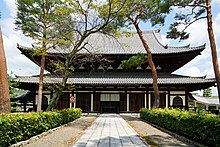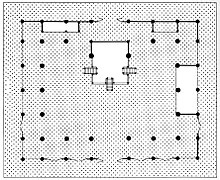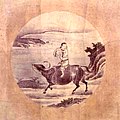Shokoku-ji
The Shōkoku-ji ( traditional spelling : 相 國寺 Reformed spelling : 相 国寺 ), correctly Shōkoku Jōtenzen-ji ( 相 国 承天 禅寺 ) with the mountain name Mannenzan ( 萬年 山 ), is a Buddhist temple in the Kamigyō district of the city of Kyoto . It is one of the seven main temples of the Rinzai-shū and as such has over 100 branch temples , including the Kinkaku-ji and Ginkaku-ji .
history
The construction was started in October 1383 at the request of the Go-Komatsu - tennōs by Sadaijin and Shogun Ashikaga Yoshimitsu and completed in 1392. Yoshimitsu chose a place east of his residence, the "Hana no gosho". The temple was part of the selection of the "Five Zen Temples" of Kyōto ( Gozan ) in 1386 and takes the second place there.
The first ruler in December 1382 was de facto the Zen master Shun'oku Myōha ( 春 屋 妙 葩 ; 1311-1388), who had ordained Yoshimitsu in 1367. Myōha had this honor nominally and posthumously conferred on his deceased uncle Musō Soseki . Myōha resigned in 1386, his successor was Kūkoku Myōō (1328-1407).
In 1393 a five-story pagoda was built 70 m high, but the following year it burned down with the temple complex. In 1399 a 100 m high large pagoda was built and Yorimitsu was present at the inauguration. But when this too soon burned down, namely in 1403 due to a lightning strike, no reconstruction was carried out.
The temple was destroyed during the Ōnin Civil War, then again in 1551, but its priests continued to strive to preserve the Zen culture. 1584 came Saishō Shōdai ( 西 笑 承兌 ; 1548-1608) to the monks and made a contribution to the reconstruction. In 1605, Toyotomi Hideyori donated a new main building, the Hatto. Tokugawa Ieyasu donated the main gate (Sammon) in 1609 and the Go-Mizunoo - tennō left a building from his palace as the tomb of the temple founder (Kaisantō). In the major Temmei fire in 1788, the system burned down again, except for the Hatto, the bathhouse and the Chokushi gate. A number of buildings were rebuilt in 1804-1818, but not the Buddha Hall, which belongs to a temple complex, the Garan ( 伽藍 ) in the Zen style, nor the Sammon.
After the Meiji Restoration , the temple lost support. The current facility covers only a fifth of the old area.
Temple complex
- Entrance gate ( 総 門 , sōmon )
- Gate for imperial messengers ( 勅使 門 , chokushimon )
- Bridge ( 天 界 橋 , tenkaibashi )
- Pond ( 放生池 , jōshōji )
- Sutrenspeicher ( 経 蔵 , kyōzō )
- Bell tower ( 鐘楼 , shōrō ) from 1843, of considerable size, also called Kyōonrō ( 洪 音 楼 ).
- Main hall ( 法堂 , hattō ). This building (28.72 × 22.80 m) is exemplary of the Zen architecture of the time. The interior of the room is surrounded by a gallery, on the altar ( 須弥 山 ) sits the object of main worship, (Go- Honzon ), a sculpture of Shaka Nyorai made by Unkei ( 運 慶 ; 1151–1223) . The painting of the ceiling with a dragon ( 蟠龍 図 , hanryū-zu ) is attributed to Kanō Mitsunobu .
- Grave hall for the nominal founding abbot ( 開山 塔 , kaisantō ). There Muso is honored with a statue. The doors (tobusuma, sugito) are said to have been painted by Maruyama Ōkyo . The front garden is called “Ryūgensui no niwa” ( 龍 渕 水 の 庭 ), although it is of the Kare-san-sui type and no water flows.
- Bath ( 浴室 , yokushitsu) from 1596, here called Semmyō ( 宣 明 ), is a steam bath.
- Abtresidenz ( 方丈 , hōjō ) from 1807. The pictures on the sliding doors (fusuma-e) in the elongated building are said to come from Hara Zaichū ( 原 在 中 ; 1750–1837).
- Gardens ( 裏 方丈 庭園 , ura hōjō teien )
- Work and reception building ( 書院 , shoin )
- Refectory ( 庫裏 , kuri )
- Museum ( 承天 閣 美術館 , Jōtenkaku bijutsukan )
The small temples and monk's clauses ( 塔 頭 , tatchū ) in the immediate vicinity (not further marked on the map) are part of the overall complex . The graves of Fujiwara no Sadaie , Ashikaga Yoshimasa and others can be found in the cemetery . The samurai of Satsuma-han , who died in the Hagurigomon incident in 1864, are buried in a neighboring area .
More buildings
- The Tatchū includes the Daitsū-in ( 大通 院 ), which also includes a zazen room ( 座 禅堂 , zazendō ), which here is called Enbutsujō ( 選 仏 場 ).
- Two small shrines are located between the bell tower and the Kaisantō.
Shokoku-ji and the arts
The monochrome painters Jōsetsu and Shūbun of the temple established monochrome ink painting ( 水墨画 , suibokuga ) in Japan. The students Sesshū , Sōtan and others followed. The painter Itō Yakuchū worked there in the 18th century and is also buried there. Many works of art in the temple can be viewed in its own museum building, the Jōtenkaku bijutsukan. A brief from Mugaku Sogen ( 無 学 祖 元 ; 1226–1286) is registered as a national treasure. The cycle " The Ox and His Shepherd " is well known, the illustration of which is attributed to Shūbun.
gallery
Fugues (Itō Yakuchū)
Remarks
- ↑ For a small fee, visitors can stand in the middle below and - after clapping their hands vigorously once - hear the famous multiple echoes ( 鳴 龍 , naki ryū ).
Individual evidence
- ↑ Mainichi Shimbun-sha (Ed.): Juyo bunkazai 12. Kenzobutsu I. Mainichi Shimbun-sha, 1973.
literature
- Folder of the temple
- S. Yamamoto: Kyoto-fu rekishi sampo (jo) . Yamakawa, 1999. ISBN 4-634-29260-2 . P. 105 ff
Web links
- Official website - Japanese and English
- Information on rinnou.net - English
- Shōkoku-ji temple at Culture-in-Asia: Part 1 with description - Part 2 - Part 3
Coordinates: 35 ° 1 ′ 59.02 " N , 135 ° 45 ′ 44.45" E







